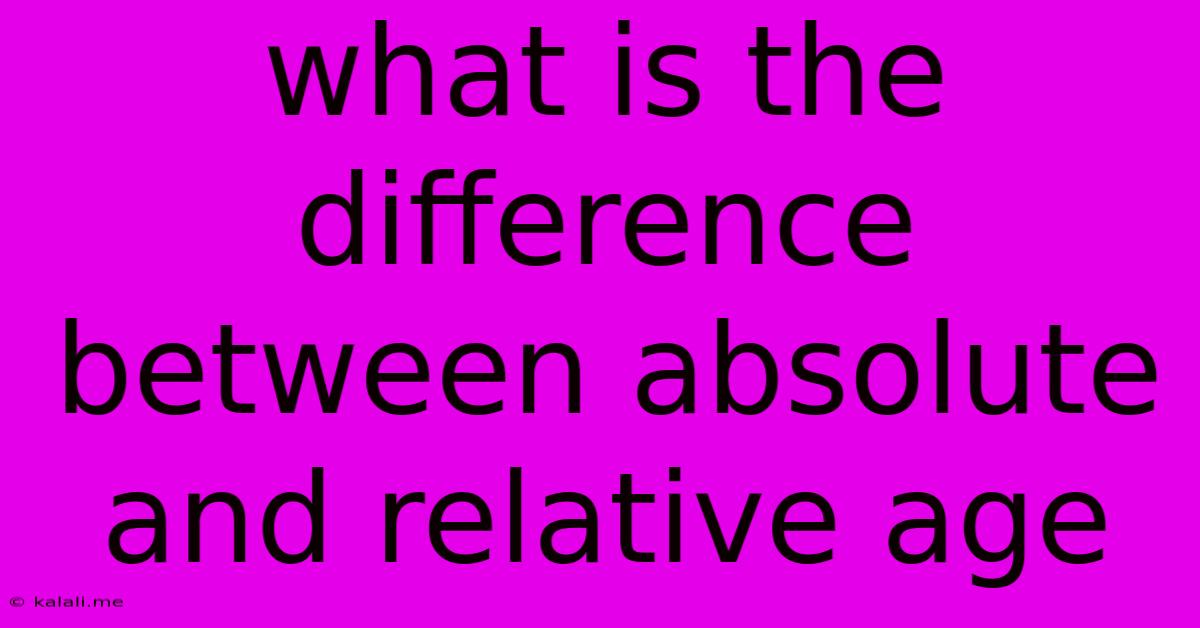What Is The Difference Between Absolute And Relative Age
Kalali
May 10, 2025 · 3 min read

Table of Contents
What's the Difference Between Absolute and Relative Age? A Geologist's Guide
Determining the age of rocks and fossils is crucial in understanding Earth's history. However, there are two distinct approaches: determining absolute age and determining relative age. This article will delve into the differences between these two methods, explaining their techniques and limitations. Understanding this distinction is key to interpreting geological timelines and reconstructing past environments.
Relative Age: Ordering Events in Time
Relative age dating focuses on establishing the order of events without assigning specific numerical ages. It's about saying which event happened first, second, third, and so on. Think of it like arranging photographs from a family album – you know the order of events but not the exact date each photo was taken.
Several principles guide relative dating:
- Superposition: In an undisturbed sequence of sedimentary rocks, the layers at the bottom are older than those at the top. This is a fundamental principle, but it can be complicated by tectonic activity that can tilt, fold, or overturn rock layers.
- Cross-cutting relationships: A geological feature that cuts another is the younger of the two. For example, a fault that cuts through rock layers is younger than those layers. Similarly, an igneous intrusion (magma that solidifies within existing rock) is younger than the rocks it intrudes.
- Fossil succession: Specific fossils are only found within certain rock layers. By studying the sequence of fossils found in different layers, geologists can establish a relative age sequence. This relies on the understanding of the evolution and extinction of different species.
- Unconformities: These are gaps in the geological record, representing periods of erosion or non-deposition. Unconformities indicate missing time, influencing the interpretation of relative ages.
Absolute Age: Assigning Numerical Ages
Absolute age dating, also known as radiometric dating, provides a numerical age for a rock or fossil, typically in millions or billions of years. This is achieved by analyzing the decay of radioactive isotopes within the material.
Radioactive isotopes are unstable atoms that spontaneously decay into stable isotopes at a known rate, called the half-life. The half-life is the time it takes for half of the parent isotope to decay into the daughter isotope. By measuring the ratio of parent to daughter isotopes, scientists can calculate how much time has elapsed since the rock or fossil formed.
Commonly used radiometric dating techniques include:
- Carbon-14 dating: Used for dating organic materials up to around 50,000 years old.
- Uranium-lead dating: Used for dating very old rocks, including those found in the Earth's crust and meteorites. Its long half-life allows it to date materials billions of years old.
- Potassium-argon dating: Another technique for dating very old rocks.
Limitations of Both Methods
Both relative and absolute dating have limitations:
- Relative dating provides a sequence of events but not precise numerical ages. It can be challenging in areas with complex geological history or where the rock record is incomplete.
- Absolute dating requires suitable materials for analysis (e.g., rocks containing radioactive isotopes). The accuracy depends on the precision of the half-life measurements and the assumptions made about the geological history of the sample. Contamination can also affect the results.
Combining Relative and Absolute Dating
Ideally, geologists combine both relative and absolute dating techniques to achieve the most comprehensive understanding of a geological sequence. Relative dating helps establish a framework, while absolute dating provides numerical ages to refine the timeline. This integrated approach provides a powerful tool for reconstructing Earth's history and understanding the evolution of life.
Latest Posts
Latest Posts
-
What Is Half Of 1 4 Teaspoon
Jul 02, 2025
-
How Many Cups In A Pound Of Hamburger Meat
Jul 02, 2025
-
Imagery Or Figurative Language From Romeo And Juliet
Jul 02, 2025
-
What Is A Quarter Of A Million
Jul 02, 2025
-
Which Of The Following Is True Concerning A Dao
Jul 02, 2025
Related Post
Thank you for visiting our website which covers about What Is The Difference Between Absolute And Relative Age . We hope the information provided has been useful to you. Feel free to contact us if you have any questions or need further assistance. See you next time and don't miss to bookmark.